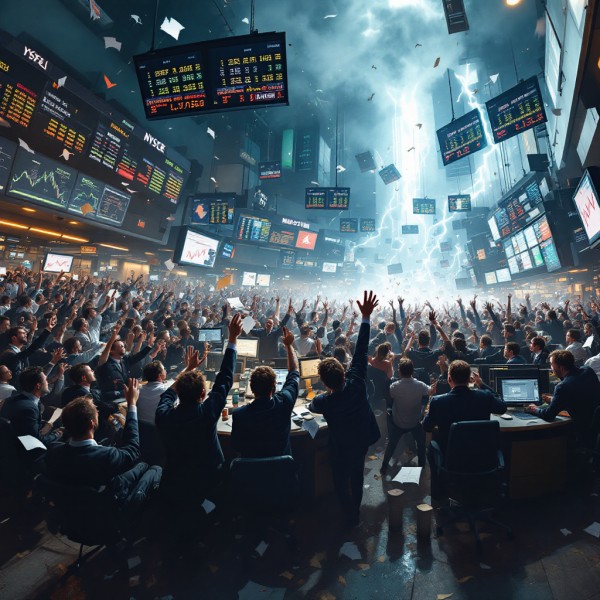US Stock Market Fear: Ignore the Noise, Follow the Trend
March 24, 2025
In the high-octane world of share market trading, emotional intelligence is as critical as technical prowess. The share market fear and greed index is more than just a gauge—the secret code unveils the cyclical dance of market sentiment. The mantra is clear: buy when fear dominates and sell when joy runs rampant. However, if you’re like the proverbial burro, always acting too late and selling too early, you’ll miss the feast while others reap the rewards.
This extensive exploration breaks down the Burro Theory, the force of mass psychology, and how technical analysis (TA) fine-tunes your entries and exits. We’ll even borrow insights from chemistry to illustrate these market reactions. By the end of this discussion, you’ll understand why market equilibrium is achieved when extreme emotions neutralize each other—presenting golden opportunities for the savvy investor.
The Burro Theory: Avoiding the Fate of the Lagging Laggard
A. Understanding the Burro Mentality
The Burro Theory posits that most retail investors, much like stubborn burros, consistently act too late. They let emotions rule their decision-making, buying at the peak of market exuberance and selling at the nadir of panic. This behaviour results in two fatal missteps:
✅ Late Buying: Investors enter the market only when the prevailing sentiment is overly optimistic, missing the early, profitable entry points when prices are undervalued.
✅ Premature Selling: Driven by the fear of impending losses, they liquidate their positions as soon as slight corrections begin, failing to capture the rebound.
Essentially, these investors are caught in a relentless cycle of buying high and selling low—exactly the opposite of the contrarian approach that creates wealth.
B. Historical Examples Illustrating the Burro Effect
Take the infamous tech bubble of 2000 as an example. Many investors bought into the euphoria surrounding internet stocks when prices were surging, driven by relentless media hype. As the bubble burst, these same investors panicked, selling their positions before the market stabilises and recovers. They became modern-day burros, stumbling into the trap of emotional overreaction and ultimately suffering significant financial losses.
Similarly, during the COVID-19 crash in March 2020, the market was gripped by unprecedented fear. Investors, overwhelmed by headlines of global lockdowns and economic uncertainty, sold off assets en masse. Those who acted in haste, letting fear dictate their actions, missed the strong recovery that followed. The lesson is unequivocal: acting too late, like a burro, results in starvation—financially speaking.
II. Mass Psychology: The Emotional Catalyst in Market Movements
A. The Power of Collective Emotions
Mass psychology is the unseen hand that drives the share market fear and greed index. When fear or greed takes hold, it spreads like wildfire—just as a chemical reaction accelerates when the right catalyst is introduced. In this analogy, investor sentiment is the catalyst that triggers market movements.
During periods of extreme optimism, the market behaves like a self-reinforcing system, where bullish sentiments beget further buying. Conversely, panic spreads rapidly when fear dominates, leading to mass sell-offs. This collective behavior can be explained by the concept of availability cascades—where vivid, emotionally charged narratives dominate decision-making, regardless of underlying fundamentals.
B. How Media Amplification Fuels the Cycle
Financial media plays a significant role in amplifying these emotional states. Media outlets flood the public with grim imagery, sensational headlines, and dire predictions when the market enters extreme fear. Phrases like “market meltdown” or “imminent crash” become commonplace, triggering an emotional contagion among investors.
Similarly, during periods of extreme greed, media narratives shift to hyper-optimism. Headlines touting “record highs” and “unlimited potential” drive investors to pile into the market, often beyond rational limits. This relentless media reinforcement magnifies emotional extremes, making the market more susceptible to dramatic reversals when the sentiment eventually corrects itself.
C. The Chemical Reaction Analogy
To draw a parallel with chemistry, think of market sentiment as a reaction mixture. When an abundance of a particular reactant (fear or greed) is introduced, the reaction accelerates dramatically. However, just as in a chemical reaction, there comes a point where the reaction becomes unsustainable, leading to a rapid shift—an exothermic burst followed by a quenching of the reaction. In market terms, this is when extreme emotions peak, setting the stage for a reversal.
The concept of chemical equilibrium is particularly relevant here. In chemistry, equilibrium is reached when the forward and reverse reactions occur at the same rate. Similarly, the market seeks a balance between fear and greed. When emotional extremes disrupt this equilibrium, they create opportunities for contrarian investors who recognize that the reaction is unsustainable and due for correction.
III. Technical Analysis: Fine-Tuning Entry and Exit Points
A. Merging Psychology with Precision
While understanding mass psychology provides the broader context, Technical Analysis (TA) offers the precision needed to time your trades. Once you’ve identified the market’s emotional state using the share market fear and greed index, TA tools help pinpoint the exact moments to enter or exit positions.
Technical indicators such as support and resistance levels, Relative Strength Index (RSI), moving averages, and volume trends are invaluable. They allow you to confirm whether the emotional extremes create temporary mispricings.
✅ Buy Signal Example:
When the index registers extreme fear (below 20), technical indicators like an oversold RSI or bullish divergence at key support levels signal an opportunity to buy. For instance, during the COVID-19 crash, many investors used TA to identify robust support levels, entering positions at discounted prices that later soared during the recovery.
✅ Sell Signal Example:
Conversely, when the index shows extreme greed (above 80), technical indicators such as overbought conditions or resistance levels can warn of an impending correction. The tech bubble of 2000 is a classic case where overenthusiastic buying, confirmed by TA signals, eventually led to a dramatic downturn.
B. Practical Strategies for Combining TA and Market Sentiment
- Three-Phase Deployment in Extreme Fear:
- Phase 1 (40% Allocation): Invest in broad market index funds (e.g., VOO, VTI) when TA signals confirm support levels.
- Phase 2 (40% Allocation): Target quality companies with strong fundamentals that have been unduly punished by panic selling.
- Phase 3 (20% Allocation): Keep a reserve to capitalize on further declines, particularly if the index drops below critical thresholds (e.g., 15).
- Option Strategies During Extreme Fear:
Elevated implied volatility during fear periods creates opportunities for option sellers. For example, in March 2020, put options on blue-chip stocks offered premium yields exceeding 25%, reflecting the heightened emotional risk. These strategies allow you to collect premiums while potentially acquiring quality stocks at even more attractive valuations if the market continues to fall. - Profit Harvesting in Extreme Greed:
When the index indicates excessive optimism, use TA to identify overextended positions and lock in gains. Systematic portfolio rebalancing—selling portions of positions that have peaked—ensures that you capture profits before a market correction sets in.
IV. The Burro Theory Revisited: Practical Lessons for the Discerning Investor
A. Overcoming the Burro Mentality
The Burro Theory warns us about the perils of procrastination in trading. Investors who mimic the burro’s behavior—delayed action, reactive selling, and emotional overreactions—are destined to miss out on market opportunities. Recognizing and avoiding this behavioural trap is crucial for long-term success.
Key Lessons:
✅ Act Decisively:
Implement a disciplined trading plan based on predetermined triggers from both the share market fear and greed index and TA signals. Avoid the temptation to second-guess your strategy when market emotions run high.
✅ Maintain Emotional Discipline:
Develop the ability to detach from the crowd. When market sentiment reaches extreme levels, rely on your analysis rather than succumbing to the herd mentality. This psychological fortitude is the hallmark of successful investors.
✅ Commit to Continuous Learning:
Stay informed about both macroeconomic trends and the finer points of technical analysis. Knowledge is the antidote to the emotional paralysis that characterizes the burro mindset.
B. Case Study: The 2008-2009 Financial Crisis
During the 2008-2009 crisis, the market plunged into deep fear, with the index dipping to levels far below 20. Many retail investors, gripped by panic, sold off their holdings. Those who remained, however, took advantage of the depressed prices by methodically deploying their capital as described earlier. As the market recovered—gaining approximately 70% over the subsequent 24 months—those who acted with discipline and precision reaped substantial rewards, while the burro-like majority suffered lasting losses.
V. The Chemistry of Market Reactions: A Refined Perspective
A. Emotional Catalysts and Market Equilibrium
Let’s revisit our chemistry analogy. Imagine the market as a complex reaction vessel where various elements (emotions, economic data, investor behavior) interact. In this vessel, fear and greed are the primary reactants, and they determine the speed and direction of the reaction.
When fear is the dominant reactant, it catalyzes a rapid sell-off, pushing prices to artificially low levels. Conversely, when greed takes over, it drives a buying frenzy, inflating prices beyond their intrinsic value. However, as in any chemical reaction, there comes a point of equilibrium—where the excess reactants (extreme emotions) begin to neutralize, paving the way for a reversal. This is when the share market fear and greed index indicates that the reaction is out of balance, and rational investors can step in to restore equilibrium.
B. Fine-Tuning with Technical Analysis
Technical Analysis acts as the precision instrument in this chemical experiment, akin to a spectrometer measuring reaction kinetics. TA doesn’t predict the future but confirms when the reaction has reached a point of inflexion. It tells you when the concentration of fear or greed has peaked, signalling the optimal moment to intervene. By aligning TA indicators with the mass psychological insights from the index, you can effectively “balance the equation” of market dynamics.
VI. Implementing a Disciplined Strategy: The Synergy of Theory and Practice
A. Establishing Pre-Defined Action Protocols
The secret to turning theoretical insight into tangible profit lies in disciplined implementation. Develop a written investment policy specifying actions triggered by particular index readings and TA signals. This removes the need for real-time emotional decision-making and ensures you remain ahead of the burro mentality.
Example Protocol:
- Extreme Fear (Index below 20):
- Deploy 40% of capital into broad market index funds.
- Allocate 40% towards high-quality, fundamentally sound companies.
- Reserve 20% as dry powder for further market dips.
- Confirm entry points using oversold conditions and bullish divergence on TA.
- Extreme Greed (Index above 80):
- Rebalance portfolios by harvesting profits from overextended positions.
- Redirect proceeds into cash or quality opportunities with stable valuations.
- Use TA indicators such as overbought RSI and resistance levels to time exits.
B. Accountability and Continuous Evaluation
Set up accountability partnerships or join investment groups that enforce discipline. Regularly review your performance and adjust your strategy based on empirical evidence from past cycles. The goal is not to predict market tops or bottoms but to exploit the recurring psychological patterns that dictate market behaviour.
VII. Conclusion: Transforming Emotional Insights into Financial Mastery
The share market fear and greed index is a powerful tool—if you learn to read its signals correctly. By understanding and applying the Burro Theory, you can avoid the pitfalls of reactive, emotion-driven trading. Instead, you can leverage mass psychology to your advantage, using technical analysis as a precision instrument to time your trades perfectly.
Remember, the market is a dynamic laboratory where emotions and data interact like chemicals in a reaction vessel. When extreme fear pushes prices to irrational lows, disciplined investors seize the moment to buy. Conversely, when unbridled greed inflates prices, it signals the time to sell. This is the essence of the contrarian strategy: buy the fear, sell the joy—unless you’re a burro stuck in the herd.
Armed with these insights, you can transform your trading strategy. By combining the broad brushstrokes of mass psychology with the fine-tuning of technical analysis, you can systematically exploit market cycles. You will no longer be at the mercy of emotional tides. Instead, you will harness the forces that cause the herd to falter, stepping confidently into a realm of disciplined, data-driven trading.
Ultimately, the market rewards those who learn to navigate its emotional chemistry. Embrace the lessons of the share market fear and greed index, avoid the pitfalls of the Burro Theory, and use every tool at your disposal to turn psychological insights into financial mastery. The result is a strategy that protects your capital and positions you to capture extraordinary returns when the market rebalances—transforming volatile cycles into sustained opportunities for wealth creation.
The Blueprint for Bold Thinking











